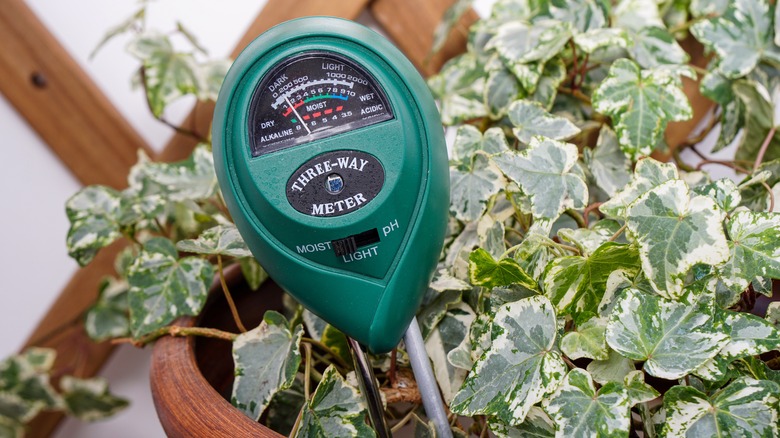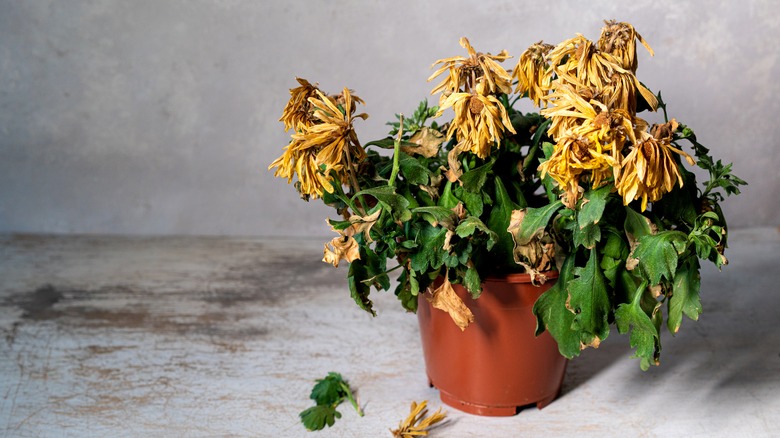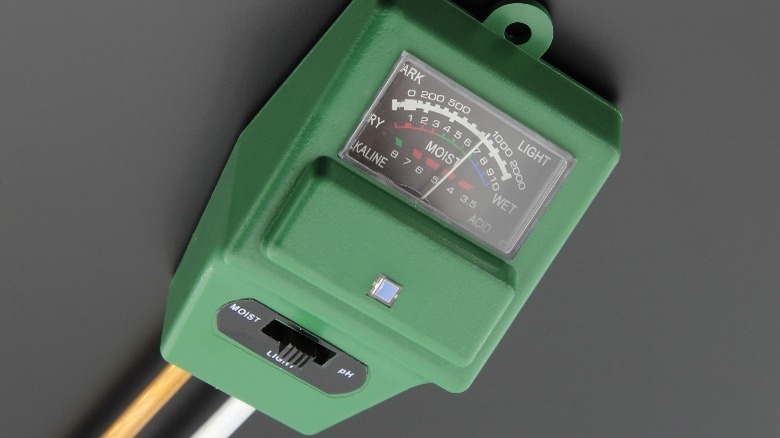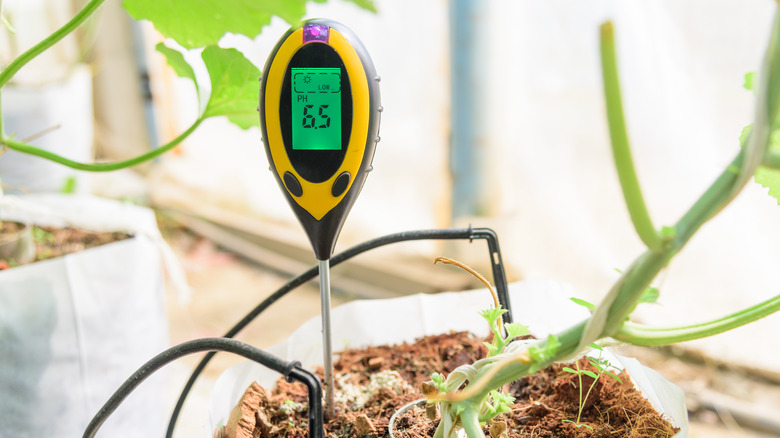What Is A Moisture Meter And Do You Really Need One For Your Houseplants?
There are a few different ways to tell if a plant is low on moisture. You could take a close look. Is it wilting? Do you see dry crispy leaves that are turning yellow or brown? Unfortunately with this method, by the time you see the damage, it's late in the game and your plant has needlessly suffered.
You could poke your finger down into the soil. The Swedish Plantguys note that our fingertips make excellent moisture meters because the skin on that part of our body is acutely sensitive. In order to get an accurate idea of the state of your soil you'll need to dig your finger down an inch or two. This might be all you need to do if you have only a handful of houseplants, but what if, like us, you have a lot more than a few? Well, if they're in small enough containers, you could pick them up. Water is heavy, and with enough practice, you'll be able to tell the difference between a saturated plant and a dry one by their difference in weight. Of course, this isn't going to be practical for large plants or those planted in heavy containers.
All of these methods will work to a degree, but if you want to take the guesswork out of watering and know for sure whether it's time to hydrate your plants or not, then it's time to get your hands on a moisture meter.
Why and when to use a moisture meter
For beginner gardeners, using a moisture meter will go a long way in helping you get a feel for just how often (or seldom) your plants need attention. It's a beneficial practice for everyone else, though, too! We're all guilty of at least occasionally forgetting about a plant for too long. We know it's desperate for a drink when we see the telltale drooping or brittle foliage. Often, however, the bigger issue is when we give a plant water it doesn't need. Per the Missouri Botanical Garden, overwatering is a major problem for most plants and is actually one of the most common ways we accidentally do them harm. That's because dry soil at the very top layer is not always a sign that a plant is thirsty.
Moisture meters are especially important for plants with deep roots that you wouldn't be able to reach with just your finger. Another reason to rely on a moisture meter instead of visual cues is that some plants aren't as easy to care for as others. Some are quite finicky about receiving exact amounts of water. A moisture meter will not only tell you it's time to water your plants, but it'll also make it clear when it is not.
Different types of moisture meters
Ask Gardening explains that there are single- and double-pronged soil meters, analog and digital options, and meters that will measure more than just moisture. They also come in different sizes, so if you only have a couple of houseplants in small to medium containers, you can probably get away with a short, single-probe meter; for larger plants seek out a device with a longer probe.
Some options will allow you to check the temperature and pH level of your soil. This can be important if you have a plant that likes particularly acidic soil, such as blueberries, azaleas, hydrangeas, and gardenias (via Gardening Calendar). There are also meters that include light sensors, which are helpful if you can't quite tell how much indirect light is enough. With multi-reading meters, make sure you have the sensor set properly for the reading you want to take. It's easy to just stick it in the pot and take a reading for acidity when what you're really measuring for is light intensity.
Finally, for the less attentive plant minders among us, there are moisture meters made to be left in the soil. Note that this will not work with most options, as it's only something you can do with a specific type of meter that'll be clearly labeled "leave-in."
How to properly use a moisture meter
Is it difficult to use a moisture meter? No. Is it easy to accidentally do it the wrong way? Of course. To begin with, as Erika Lodes points out on YouTube, moisture meters shouldn't be placed directly into water; you'll only confuse the sensors and get back a reading that makes no sense. Second, as we mentioned above, the majority of meters aren't meant to be left in the soil after the reading has been taken. If you do so, the moisture reading will become inaccurate.
When you're ready to get started, simply press the probe(s) straight down into the soil and give the instrument a few seconds to take a proper reading. Make note of the moisture level and then pull the meter out and stick it into another part of the pot. Taking a few readings will give you more information to ensure the soil is drying out evenly and doesn't have any oddly damp spots next to drier ones. Be mindful of root systems when poking around with the probe. Plant care experts at The Growing Leaf say to always insert the meter gently and stop pushing when you feel resistance. If you notice the metal probe on your meter is starting to rust, it's time to get a new one.
Interpreting results on a moisture meter
Once you see the results on your moisture meter you'll need to consider the water requirements of each individual plant. Rubber trees and cacti, for example, like their soil to completely dry out before their next watering. So you wouldn't water these plants until the meter is measuring moisture at the lowest degree. On the other side of the coin, there are plenty of plants that prefer their soil to stay consistently moist; think about Boston ferns, calatheas, and philodendrons. Those types of plants might like to be watered by the time you're seeing a reading closer to the middle of the scale, notes Erika Lodes (via YouTube).
Siebenthaler's Garden Center offers a very handy chart to help you gauge exactly what reading you're looking for to know it's time to water specific plants. Meters will have either color zones, a 1 to 10 number scale, or both. The color zones are usually represented as red for dry (1 to 3), green for moist (3 to 7), and blue for wet (7 to 10); anytime your meter reading is in the blue zone, you'll know you can refrain from watering that plant.
Common issues with moisture meters
Though they're useful devices, moisture meters are far from infallible, and over time, you may start to see readings that don't add up; for instance, a dry red zone reading for a plant you can tell by look or feel is still moist. According to Laidback Gardener, this is because the simple, inexpensive instrument you're likely to pick up at the garden center is only going to give accurate readings for so long.
If you're container gardening with terracotta pots you'll eventually notice a crusty white buildup of salt, calcium, and other minerals around the edges of your pots. Per Bloom Sprouts, this is a normal result of using hard tap water and fertilizer. Laidback Gardener concurs, explaining that this residue builds up within the potting soil as well. In the case of a plastic pot, that means it might not be visibly noticeable, but you'll see it by way of the inaccurate readings you start to get. The excess minerals throw off the moisture meter's ability to properly measure the conductivity of whatever water is present. Another problem with these minerals is that they can cause the metal probe to oxidize and rust.
Repotting your plants on an annual basis can help keep soil conditions normal enough for accurate readings, but not all plants respond well to that. At the end of the day, your trusty pointer finger is always going to be a more reliable tool than any piece of technology.





